Panty & Stocking with Garterbelt: Breaking the mold of classic feminism
In 2010 Studio Gainax created Panty and Stocking with Gartbelt. A raunchy comedy about two fallen angels named Panty and Stocking Anarchy, who are forced to slay ghosts to earn their way back into heaven. The 13 episode series was praised for its art style reminiscent of western cartoons and the twist ending that surprised fans. But like one of Gainax’s previous shows, Fooly Cooly, PASWG’s comedy also works as a commentary on how society approaches and views sexuality. Fooly Cooly was more about the sexual insecurities that adolescents deal with as they’re coming of age. PASWG, on the other hand, is mostly about sexual deviance in society. It openly mocks the hypocrisy and exposes flaws with popular feminist rhetoric. Most notably, Lara Mulvey’s theory the “male gaze.”

The Male Gaze
In 1975 Laura Mulvey wrote, “The visual pleasure and narrative cinema.” In it, she criticized three of Alfred Hitchcock’s films to prove the existence of “the male gaze” (Mulvey, luxonline.org). According to Mulvey, the “male gaze” (Mulvey, luxonline.org) is a subsection of “gaze theory” (Mulvey, luxonline.org) that focuses on how female characters in visual media are objectified for the viewing pleasure of males. Lara Mulvey believed that if we could understand how gaze theory worked, we could prevent female characters from being exploited in visual media. Now, most people will agree that this has yet to become a reality. The reason for that is a lack of normalization in female sexuality.
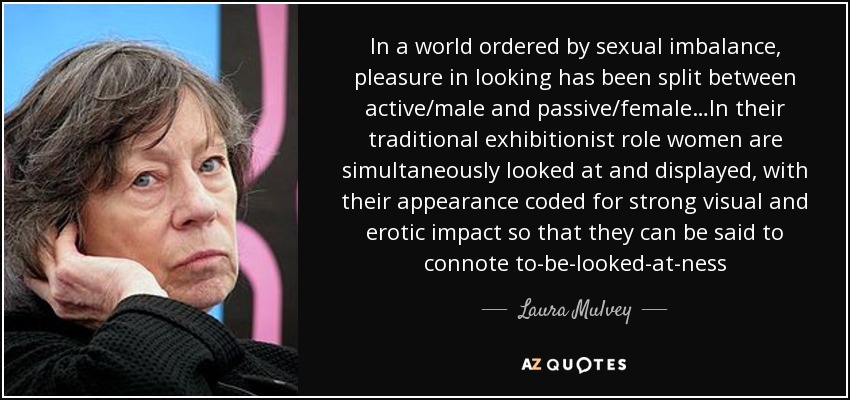
The idea be putting forward is not an original one. It originates from sex-positive feminism. It is a more recent school of thought within feminism formed in the early 1980s. It believes sexual freedom is closely tied to gender equality. The ideas held by sex-positive feminists are, at times, divisive as many support pornography and the hookup culture. This is because they do not believe raunchy displays of sexuality are inherently degrading. Instead, they think approaching sex in a way that allows men and women to explore their sexual desires can lead to sexual liberation. This not only allows individuals to maintain their dignity but also their safety and ability to give consent. That last part needs to be stressed, as it is often disregarded when looking at the ideas held by sex-positive feminists.
The main counter-argument against this concept is that it’s believed that sex-positive feminist actions only help maintain patriarchal power over women. This is due to the history surrounding raunch culture, the practice of openly displaying one’s sexuality. Traditional feminists like Ariel Levy believe that raunchy displays of sexuality only uphold patriarchal institutions. This is because raunch culture is typically only acceptable in male spaces like strip clubs and porn sites. Ariel Levy and other traditional feminist fear support could turn into validation for women engaging in debaucheries that could be exploited by men. This concern is understandable. An important aspect that is overlooked is that women are still allowing how they display their sexuality to be dictated by others’ ideas.
Instead of pursuing sexual practices that are fulfilling to themselves, women instead hide their desires. Those who openly explore it are mocked for it. This practice is better known as slut-shaming. The problem with traditional feminism is it only addresses the inequalities that women face when exploring their sexuality. But it does not have the tools necessary to help with allowing women to express their sexuality. This is why female characters often lack nuance in regards to their sexuality in visual media.
Archetypes for Her
Typically female characters fall into one of four archetypes when depicting their sexuality. You will have a virgin, someone who has no sexual experience. Then there is the seductress. This character is experienced in sex and occasionally uses it to manipulate others. You also have the wronged woman, a character who has been spurned by her lover. In some cases, they also suffered some form of sexual violence. Finally, the iron maiden is a character with no discernible interest in sex and is mostly career-oriented. These archetypes are typically interchangeable with other ones, such as the seductress could be swapped for the femme fatale. This is because any difference between them and their altered variations are mostly pedantic.
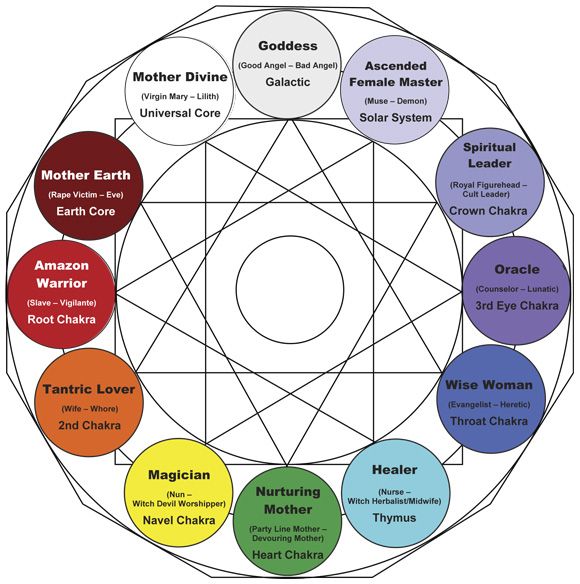
There is nothing wrong with using archetypes for constructing a character, as they are often used as the foundations for a character’s role in a story. But typically, they are then developed to further to make them unique. This leads to a more nuanced character. The problem with this is that a female character’s sexuality rarely moves past the archetypes they pull inspiration from. This could be due to no one wanting to address the female character’s sexuality. As when female characters display that aspect of their life, it leads to backlash about being exploited for male viewers. The best example of this can be seen with Lara Croft.
What is Objectification?
Since her debut in 1996, Lara has been the source of debate surrounding how female characters are portrayed in visual media. The original Lara is often cited as an example of a negative representation of female characters in gaming. Regularly this version of Lara is considered “made by men for teenage boys” (TheVerge, Plante). While the 2013 reboot, Lara is viewed as a triumph over “trashy intentions…repurposed for good.” (TheVerge, Plante) But this is clearly a misrepresentation of Lara Croft’s character in the original series and her lead designer Toby Gard’s intentions.
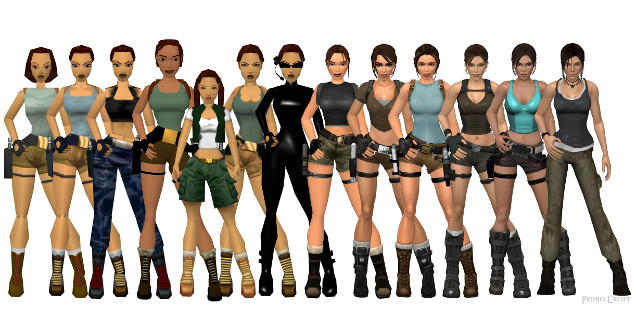
In a 1998 interview with Gamasutra, Toby Gard went on to say that “It was never the intention to create some kind of ‘page 3’ girl to star in Tomb Raider. The idea was to create a female character who was a heroine, you know, cool, collected, in control.” (Gamasutra, Gard) In his interview, he acknowledges how he exaggerated certain features on Lara but defended the design.
It’s ridiculous to say that portraying stylized people is degrading. You can represent an over the top hero figure by augmenting characteristics like a jutting jaw, wide shoulders, thin waist, etc. (Gamasutra, Gard)
In-game, Lara is not objectified. Objectification does not mean merely having a specific body type. Objectification is the process in which a character is reduced to an object. This is often done by having a hyper-focus on a character’s physical traits. This makes “their appearance coded for strong visual and erotic impact so that they can be said to connote to-be-looked-at-ness.” (Mulvey Luxonline.org) When attention is drawn to a character’s physical traits for no reason other than voyeurism, that is when they are being objectified. Despite what people would like to say about the classic Lara, this does not occur in the game. Never in-game is she framed to lead the player to focus on her in a sexually voyeuristic manner. The camera’s only purpose is to the story and highlighting clues for gameplay. To look at Lara in a voyeuristic way, the player would have to use the camera to look at Lara actively.
Sex Sells

The hypersexuality most associate with Lara comes from the advertisements used to market the game. Almost all the ads for the early Tomb Raider 1996 games had a sexual undertone. The best example of this comes from the Tomb Raider 1996 sweat commercial. In this commercial, a nude woman can be seen while a man is kissing along her neck, with the narrator asking, “what makes you sweat.” This ad does not accurately portray what the game is about. Nowhere in-game is there a scene where Lara is romantically involved with anyone. Nor is there much sexual tension. Most of the game is an action-adventure. This ad creates a cognitive dissonance between Lara in marketing versus the game. This leads to a misrepresentation of her character. This is one reason Toby Gard left after the first Tomb Raider, as he wanted “more extensive control over marketing and PR decisions” (Gard, Gamasutra). There is no doubt that the commercials marketing the character used sex appeal to sell the game. But the nature of Lara Croft cannot be judged off that alone as her in-game depiction is entirely different. Lara’s early incarnations did live up to Toby Gard’s goal of a “cool, collected, in control” heroine.
Here Comes a new Challenger
The Mass Effect Series (specifically Mass Effect 2) is one of the clearest examples of female objectification. Due to the way the game frames the scenes so the player can observe the female character’s bodies. This is most noticeable in the dialogue segments involving Miranda. As when Shepard is talking to Miranda, the camera tends to find its way behind her. This is done whether you are playing a male or female version of Shepard. This is because Miranda was initially planned to be the first bisexual non-Asari character in the series. Add to the fact that Shepard is often framed in a low angled shot during these scenes; it becomes clear that this is meant to fulfill a power fantasy for the player. And the player is clearly expected to identify with Shepard. Since Shepherd is created by the player and Shepherd’s choices are the player’s choices. The Tomb Raider series differs in this regard. This is because the story only acts to give context for the players’ actions in Tomb Raider (1996). The same cannot be said of Mass Effect since the player choosing how the story develops is part of the game. This is an important distinction as it is the key to separating sexual attraction from sexual objectification.

What sexual objectification does is reduces a person down to an object. This makes them a thing to be acted upon to fulfill one’s own sexual desires. While when someone develops a sexual attraction, it is an occurrence that happens when an individual finds traits appealing in another. This is because it occurs free of the visual tricks that we use to simulate sexual attraction in visual media. But are the female characters in Mass Effect merely an object for the player to enact their sexual fantasies?
From a technical standpoint, yes, the women of Mass Effect are only objects. And so long as the player fulfills specific requirements, they will always successfully court the character of their desire. But what objectification does is it reduces an individual to merely being an object, and the women of Mass Effect have too much nuance to be only an object. When one actually thinks about Miranda’s character, they will see several layers to her personality. On the surface, Miranda is an abrasive person. She regularly talks about her abilities and arguably perfect genetics, but this is due to her insecurities about her creation. This insecurity stems from the fact that she was cloned from her father’s DNA, and everything she has accomplished was planned by either her father or the Illusive Man. This deepens her insecurities and is one of many reasons for her having high standards for herself. She desires to prove to herself that she is more than a tool for others to use.
Her high standards also carry over to her romantic life. It is never directly stated, but if the player takes the time to read the Shadow Brokers dossier on Shepard’s crew, they will learn many personal secrets. One of Miranda’s secrets is that she uses a dating site known as IPartner Connections. And despite looking for a partner, she is often reluctant to talk to the men who message her. She often will immediately dismiss them if their medical history does not meet her standards. Miranda is also one of the few characters that have shown an interest in starting a family. But due to her genetics physically cannot.
Miranda is a paradox due to being clearly objectified. Despite that, her character is given enough depth that her body cannot merely define her. This line from the film Who Framed Roger Rabbit by Jessica Rabbit is the best example of the paradox surrounding Miranda, “You don’t know how hard it is being a woman looking the way I do.” (Who framed Roger Rabbit 1988) This line perfectly encapsulates the problem surrounding female characters in visual media. Because even when female characters are given an elaborate back story, they often become the target of sexual exploitation. This is something that male characters rarely have to face. Because typically, when the female gaze is introduced to visual media, it is in service of a power fantasy.
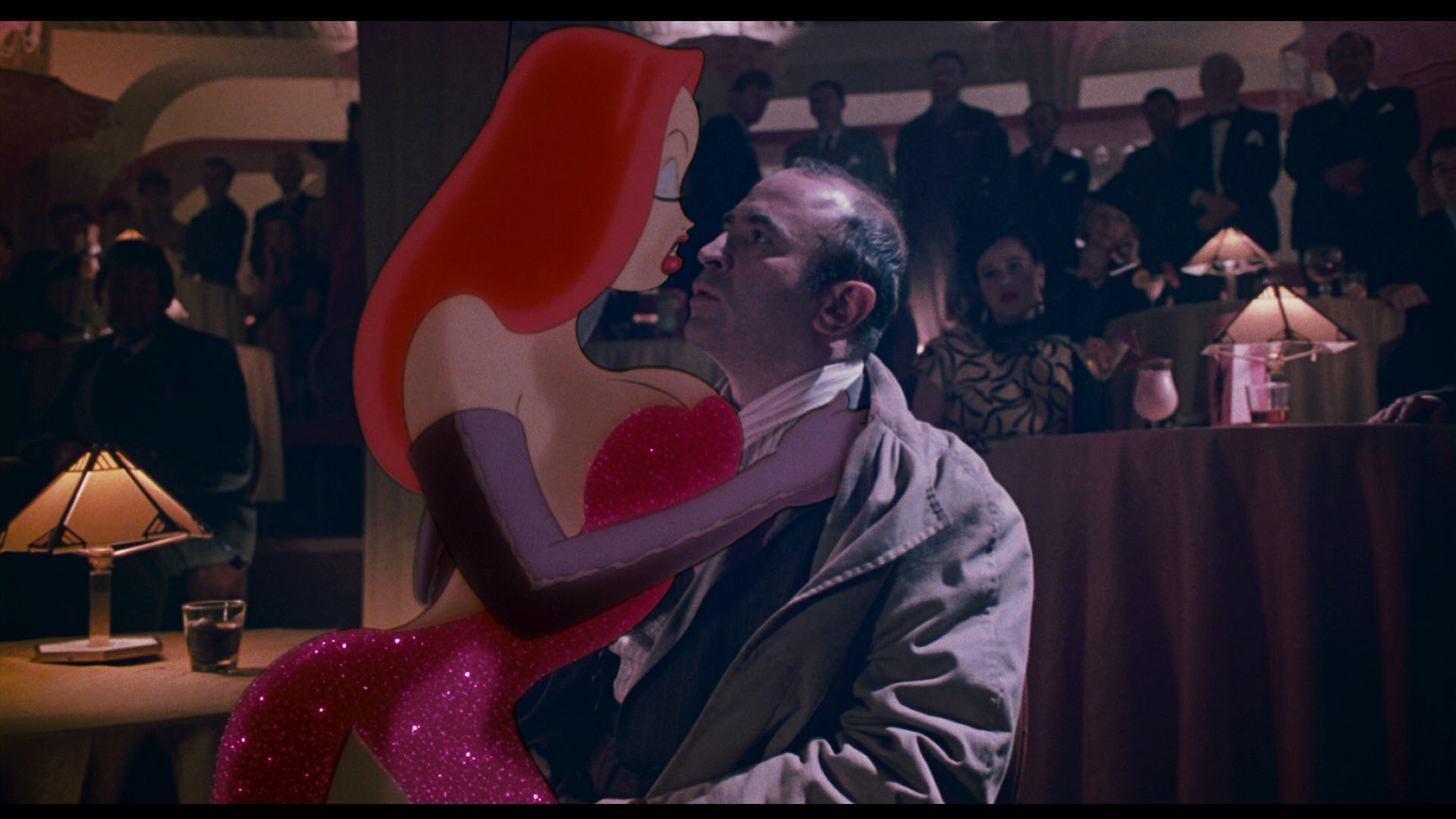
The Female Gaze
Typically the female gaze enters visual media after a thin or overweight male character becomes incredibly muscular. After the transformation, they become more desirable to the females in their series. The best example of this can be seen in how Akira becomes sexually desired by the girls at his high school after becoming the Devilman in Devilman Crybaby. His human form becomes much taller, muscular, and sexually endowed. But despite the female gaze often being used to reinforce the male power fantasy, it is just as detrimental as the male gaze. Since the female gaze is still reducing an individual down to an object, this leads to a negative body image, much like the male gaze. The pressure put on individuals to attain a body type purely for sex appeal is unhealthy. This is mainly because the features displayed are often unachievable. Since animation and film exaggerate certain traits through editing. But society still expects people to achieve these looks somehow and overlooks those who fail to. This pressure can lead to insecurity and anxiety. It’s for this very reason that sexuality needs to be acknowledged and normalized for everyone.

Raise a Little Hell
So far, the closet piece of visual media to actually do this is Panty and Stocking with Garterbelt PASWG. It exposes many of the problems surrounding women’s status and how both genders view sexuality in media due to it being a satire. It openly acknowledges aspects covered here and exposes the inherent hypocrisy behind sexuality in society.
The men of PASWG are almost all deviants. Throughout the series, you can see the men lusting after the women in the background. Taking any opportunity to look up a skirt or have some form of sexual release. Despite it never being actually verbalized, the women are clearly treated as objects to fulfill those desires. This is most evident in the sequences where Panty and Stocking are seen transforming to fight the monster of the week.
Now, typically Panty and Stocking are drawn in style reminiscent of the late 1990’s western cartoons. But for these sequences, they are drawn in style like a modern-day anime. The way they are framed in these segments is meant to highlight their bodies. This is all done while the men cheer them on. They have hearts in their eyes and their tongues hanging out their heads. Clearly, this segment is satirizing the magical girl transformation sequence in anime. The fact that this trope was chosen to be satirized is essential. Since magical girls typically represent female characters that have power without discarding their more feminine traits. Yet, in PASWG, the magical girl transformation is literally treated as a striptease.

The reason for this is to mock how this trope was initially meant to be a celebration of the power that female characters could wield while never discarding their feminine aspects. But now it is used as a means of sexually exploiting female characters. This is done through fan service moments via panty shots and states of half dress. Examples of this can be seen in Kill La Kill, Demon Fighter Kocho, One Punch Man, and Fate/Kaleid. This displays how easily actions intended as a form of female empowerment can be subverted for sexual exploitation. The harsh reality that PASWG brings to light is no matter what women do; there will always be individuals who can exploit and objectify them. This is why removing certain body types and hiding a female’s sexuality is pointless. Those who want to can still take advantage of it for their own sexual gratification. This raises the question of how do you stop sexual exploitation when it can occur despite the intent?
The way PASWG handles the problems surrounding sexuality is through satire. Like many other satires, PASWG exposes the inherent hypocrisies of society. One such example is in the episode “Sex and the Daten City,” where Panty reveals her sex tape at her film’s premiere. This act is immediately met with backlash. It leads to her becoming a pariah, and her sponsors that initially supported her film cut ties with her. This is done similarly to the way many real-life celebrities are treated when their sex tapes are revealed.
The hypocrisy of this situation is that people publicly have a problem with pornography. But when they’re alone, they have no issues with indulging in it. This shows that the stigma surrounding pornography is mostly a performance. Instead of actually being honest about their desires and who they really are, people would instead present a facade. That is something that Panty and Stocking do not do in the series, and this is mostly what sex-positive feminism is about. It is not about going out and overindulging in sex despite that being something Panty often does. It is more about pursuing a sexual lifestyle that suits the individual. This is vital not only for female characters but also for all media characters if sexuality is to become normalized.

The praise many artists and writers get for creating characters like the 2013 Lara Croft is problematic. As they never adequately address the questions about how sex appeal should be handled. These acts are more regressive than progressive. In Tomb Raider 1996, Lara’s sexuality was on display during the story. She would actively respond to men like Larson Conway when they flirted with her. Her response was a part of her character. Instead of addressing the complex history surrounding how we view sex appeal and sexuality in visual media, the 2013 Lara Croft removes it. This leads to simplistic characters that entirely avoid that conversation. Ultimately all this does is create females characters who appear Asexual or have their sexuality be a non-factor for most of the story. If that were a deliberate choice the writer made, it would be fine since being reserved sexually is a character trait. But based on the interviews and articles, it seems writers want to address this topic. They want to acknowledge how women have been treated and how they are viewed sexually. For that to happen, writers have to make a real statement.

This does not mean every character should be like Panty and Stocking or that every female character should star in their own raunchy comedy. The issue surrounding sex in visual media is a serious problem. Whether we are talking about using sex to sell products, exploring sexual identity, having a healthy body image, or depicting sexual violence in visual media. Yet, when discussing that aspect about female characters like Lara Croft, we put a much heavier focus on their appearance. When instead, we should be focusing on how sex shapes their character or factors into the narrative.
Many articles on sites like The Verge and Forbes like to praise Lara 2013 for her sense of agency. But, these traits already existed in the classic version. There is even a credible argument that the classic Lara had more agency than the current interpretation. Lara 2013 often finds herself forced to continue her adventures due to the magical item she is pursuing. This is because the events only give her one path forward. In the 2013 game, she is literally trapped on an island unless she solves the mystery. While the classic Lara could choose to stop her quest at several points, but decides to continue forward anyway.
There is no denying some of the more problematic aspects surrounding characters like the 1996 Lara or Miranda from Mass Effect. But often, the issues people take with them is limited to their bodies and ignore other aspects of their personality. Critics should start raising their standards for female characters beyond they exist, and they are dressed conservatively. Until that happens, we will never be able to explore sexuality healthily properly.
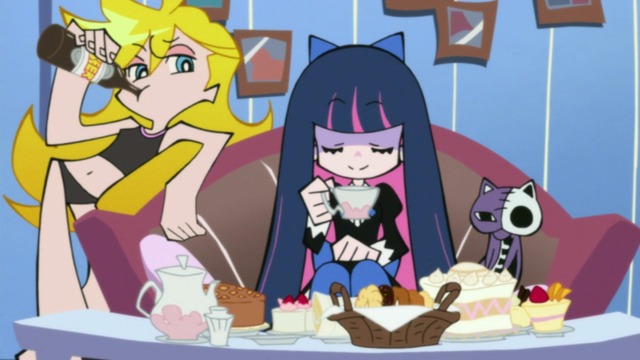
B***H Girl
What should be learned from PASWG is sexuality is fluid and will be unique for every individual. Simply expecting characters to adhere to one set of values will not work. This best seen in the last two episodes of the series.
Near the end of the series Stocking returns to heaven after gathering enough heaven coins, while Panty is left behind. This is done because instead of hunting ghost like Stocking, Panty chooses to have sex. Something she continues to do even after Stocking has left. This leads to her getting her hymen magically restored. It’s implied that this is punishment for her irresponsible behavior and Garterbelt knowingly played a role in this. Her restored hymen left her unable to access her divine powers and robbed her of her status as an angel. After hitting the lowest point in her life Panty decides to live a more wholesome sex-free life on a farm with her grandma.
While there is no denying that Panty’s lifestyle gets in the way of her duties as an angel, her grandmother disapproves of the change in her character. She goes on to tell Panty that “A woman is a free creature. Do what’s in your heart” (Tracie, PASWG S1: E13). The lesson Panty’s grandmother was trying to teach her was that not everyone is going to approve of how you live your life. But that doesn’t mean that you’ve made the wrong decision. So, long as you’re living life on your own terms. This mentality is what ultimately saves the day. Panty’s lack of shame over who she is allows her to lose her virginity and regain her angelic powers.
Sure I’m just a little Bitch and proud of it. But, guess what douche bag? That’s not the point. News flash I don’t need special fucking powers to beat the shit out of you. You and your half-dead face can give a speech about hymens, demon, and whatever weird words supposedly mean shit. But doesn’t change the fact that if any of you twisted mother fuckers get in my way I’m going to kick some twisted ass assess. Hear me dick I’m a hot bitch named Panty and no matter anyone says I do what I fucking want. (Panty Anarchy, PASWG S1: E13)
What needs to be understood about sexuality is how it’s displayed is going be different for everyone. While those displays certainly can be criticized and examined, ultimately, individuals need to be true to themselves. And while not everyone may agree with that decision. There should at least be respect for it. Otherwise, we will return to a time where people were persecuted for their sexual practices.
Works cited
Collector, Tomb Raider. “Tomb Raider 1 ‘Sweat’ (TV Commercial, Spot, 1996).” YouTube, YouTube, 20 Feb. 2013, http://www.youtube.com/watch?v=EWdlU-lwgVY.
“‘Female Chauvinist Pigs’ – Feminism Triumphant – or Its Downfall?” talk_politics, talk-politics.livejournal.com/998267.html.
Francis, Tom. “We’ve Played the Controversial Tomb Raider Scene, Here’s What’s Really Happening.” Pcgamer, PC Gamer THE GLOBAL AUTHORITY ON PC GAMES, 12 July 2012, http://www.pcgamer.com/weve-played-the-controversial-tomb-raider-scene-heres-whats-really-happening/.
gamevidguy. “G4 Lara Croft Tomb Raider Beach Commercial.” YouTube, YouTube, 29 Nov. 2007, http://www.youtube.com/watch?v=s6yg3-596TQ.
“Male Sexualization in Video Games.” Widgetau.org, widgetau.org/male-sexualization-in-video-games/.
Pinchefsky, Carol. “A Feminist Reviews Tomb Raider’s Lara Croft.” Forbes, Forbes Magazine, 12 Mar. 2013, http://www.forbes.com/sites/carolpinchefsky/2013/03/12/a-feminist-reviews-tomb-raiders-lara-croft/#128676ea5d92.
Plutonic and Volcanic Rocks, http://www.friesian.com/gender.htm.
Romano, Aja. “Why We’ve Been Arguing about Lara Croft for Two Decades.” Vox.com, Vox Media, 17 Mar. 2018, http://www.vox.com/culture/2018/3/17/17128344/lara-croft-tomb-raider-history-controversy-breasts.
Schreier, Jason. “You’ll ‘Want To Protect’ The New, Less Curvy Lara Croft.” Kotaku, Kotaku.com, 19 June 2013, kotaku.com/5917400/youll-want-to-protect-the-new-less-curvy-lara-croft.
“Sexual Objectification Vs Sexual Attraction « The Daily Blog.” The Daily Blog, thedailyblog.co.nz/2014/02/11/sexual-objectivfication-vs-sexual-attraction/.
“Sexual Objectification: What It Is, Why It’s Damaging, and How We Change It.” Upworthy, Upworthy, 23 Jan. 2014, http://www.upworthy.com/sexual-objectification-what-it-is-why-its-damaging-and-how-we-change.
Shane, Charlotte. “Ariel Levy’s Infuriating Memoir of Privilege and Entitlement.” The New Republic, 10 Mar. 2017, newrepublic.com/article/141261/ariel-levys-infuriating-memoir-privilege-entitlement.
“The Short, Sexist, & Slightly Surprising History of the Wet T-Shirt Contest.” Mic, Mic Network Inc., 25 Mar. 2016, mic.com/articles/138633/the-short-sexist-history-of-the-wet-t-shirt-contest-a-symbol-of-spring-break-debauchery#.67jsCVADP.
Talks, TEDx. “Feminist Porn: Shifting Our Sexual Culture | Olivia Tarplin | TEDxJerseyCity.” YouTube, YouTube, 30 Mar. 2015, http://www.youtube.com/watch?v=x38-iHvUqLY.
Timmins, Debbie. “Tomb Raider – Crossroads: The Truth About The Lara Croft Rape Controversy.” Sabotage Times, Sabotage Times, 19 June 2012, sabotagetimes.com/life/tomb-raider-crossroads-the-truth-about-the-lara-croft-rape-controversy.
“Young Feminist: Sex-Positive Feminism & Safety.” NWHN, 21 Mar. 2017, http://www.nwhn.org/young-feminist-sex-positive-feminism-safety/.
What do you think? Leave a comment.











Great article. I agree with everything. It’s a show that treats female characters on exactly the same playing field as male characters without over-glorifying their sex appeal.
Panty & Stocking is, undoubtedly, one of the best examples of positive feminism being used in a tv show that I’ve seen in quite a while.
The more I think about it, the more I realize what a great example of positive feminism Panty & Stocking With Garterbelt is.
The level of depth and contrast look stunning, I don’t remember this show having such attractive art assets. It seemed so vulgar and western I didn’t think they’d change it up to look like this. I know its Gainax and anything they touch warrants a curious glance, but I just couldn’t get over the whole powerpuff girls and rainbow look (no matter how offensive or profane their mouths may be!) it looked strictly unjapanese.
Really nice work with this analysis.
I really commend Gainax as a creative studio. One might dismiss their audacious style or criticize them for being a bit too otaku-centric at times, but they never take a day off or phone it in. They seem to cherish their wildcard role in the industry.
I would argue that Panty & Stocking with Garterbelt is actually quite anti-otaku in the way it’s drawn and the general air of promiscuity it exudes.
Panty & Stocking with Garterbelt is very much a series so-called hipsters would be watching.
I enjoyed reading your article but I did not enjoy this anime. Gainax has more than enough artistic skill, yes, but such artistry could be used for something a little more worthwhile than an excessively elaborate sandcastle aimed at the Adult Swim crowd.
It dares to be stupid, crazy, and FUN…which is a high compliment in the realm of “SERIOUS BUSINESS” anime.
It might not be your cup of tea, but it exemplifies what anime needs more of: high-energy cartoons that aren’t afraid of being silly, and more importantly, cartoony.
I remember watching Panty & Stocking and thinking, what the…? But it was just crazy fun. Just by a glance a person who hasn’t heard of this show would think that it was a kid’s show but nope, nope, nope. It was a idgaf what you think, in your face, crude, over the top anime with some sentimental moments that gets you. Sometimes I wonder if the people who made Bojack Horseman saw this show as well.
I watched it recently and I loved it.
I’m curious though, what did you think of the ending?
The ending was good for building hype for a possible second season. Some fans even started working on a continuation of the series when the realized Gainax wasn’t going to continue the series.
It personally took my by surprised and when I first saw it. I was immediately looking for season two (as I watched it for the first time in 2015 during my time in college.) Now it leaves me mostly frustrated as I would like to know why Stocking betrayed Panty.
I thought the ending was weird, left me asking many questions that probably will not be answered, and open (Like there is a hole in the wall).
A shame we never saw a continuation of this show, but considering how random it was, it seems kind of fitting for it to end on a cliffhanger that came completely out of nowhere.
The entire show, was a build up to that ending. Which is probably the most meta joke in a very long time.
A true Gainax ending, if there ever was one.
Am I the only one that finds the animation to be a bit of an eyesore? I appreciate the work that went into making it both unique and reminiscent of western cartoons, and I have nothing against bright colors, but I think they were utilized poorly in the show. They tend to clash and make it hard to determine the focal point of each shot. Maybe I’m just abnormally sensitive to that sort of thing, but it’s still a major roadblock to my enjoyment of the show.
Panty & Stocking is one of those series I clump in with Space Dandy where they have amazing animation, style for days, and I want to like them SO MUCH.
But they’re comedies that I just don’t find funny at all… I can’t think of a solid joke I’ve laughed at in either. I’ve tried watching both multiple times yet I never make more than a few episodes.
Japan needs to make more american influenced anime like this one. The humor was so dirty and amazing, and the animation was smooth, sexy and fun. Such an underrated show.
It was an awesome show that totally deserves more praise and notoriety
Although this may well come across as a backhanded compliment, now that I think about it…I find your analysis to be more interesting than the show itself and its self-indulgent experiments in boldness that lead to little more than visceral amusement, on one level, and loads of stylistic fodder for said analysis, on the other.
The compliment doesn’t feel backhanded to me. Your feelings about PASWG seems to be the norm from my experience. Most of my friends hated this show when it came out (most still do). And from what I’ve read in the comment section, most people seem to be split on the show as a whole. Some either like the wild, unpredictable nature of the show. In contrast, others like yourself would have preferred a more grounded and consistent art style.
This is a completely fair criticism of Gainax. It’s very jarring when you have a series constantly changing how it looks. It takes you out of the experience and reminds you as a viewer that you’re watching a cartoon.
And you’re spot on about PASWG being good for analysts, but not viewers. I love to pick through studio Gainax’s works and see all the references to different animated shows. They’re is probably the most Avant-garde studio still in the business.
But just because you’re breaking the norms doesn’t mean it’s a good idea. Norms in art become norms because they work. And if you don’t have a good reason for breaking them, it becomes self-indulgent like you pointed out.
While Gainax was trying to do it for comedic effect. I feel unless you’re really familiar with animation of the 1990s-2000s some of the jokes might be missed. And even when you do notice them they might not be that funny. Teen Titan’s go has a similar problem (though they’re mostly trying to chase the superficial trends that show’s like Adventure Time, Gumball, and Annoying Orange started.)
Anime, as ever, is at its best when it’s unpredictable.
I never expected such a drastic shift in tone from Panty and Stocking with Garterbelt.
Very interesting article. I liked it a lot, but I do want to point out that when you mentioned Kill La Kill as an example of objectification with the transformation sequence I don’t think you were taking into account that Kill La Kill is just as much of a satire. The whole show is making fun of/ pointing out the ridiculous fan service that is common in anime (especially shounen). Once again, great article, I just wanted to give Kill La Kill it’s fair defense.
You’re absolutely right. The same could be said of Fate Kalied as it is mostly a parody of the mainline Fate Series. When I was writing, I was mostly thinking of what shows use the transformation sequences for fan service. But, as you said, not all my examples can be viewed in the same context. After reading your comment, I’d honestly remove these two from my list of examples as their intent is more in line with what Gainax is doing in PASWG.
They’re sexually liberated in their own way and not just a way that panders to the viewer, and I love that.
Panty and Stocking was refreshing and fun at first but after three episodes I found myself losing interest in it. It was the point where respecting what a production was doing and wanting to watch it are two subtly different things.
Panty and Stocking is easily one of the animes that just works, maybe even better, dubbed. From the more Western artstyle to the comedy style (Reminds me of something that would be on Comedy Central or Adult Swim).
Goddam I love this series Dubbed. Shame they ended it the way they did (or rather, how they didn’t end this series at all).
Are there people who watch this with subtitles?
If I recall correctly, watching it dubbed is the “correct” way to watch it. Since that’s what the creators intended. The team behind PSG (Now known as Trigger, but at the time they were in Gainax) wrote PSG as a sort of love letter to western media and how wild and unapologetically raunchy it can be. That’s why even the original work is filled with random english swears, and why they specifically asked for the dubbing to be as raunchy and dirty as possible.
God bless this show!
Panty and Stocking is one of those shows you think is Family Friendly but really isn’t once you watch it like I can imagine a family member with their family and is like ” Oh this looks nice. ” and their children gets exposed to it all.
It’s just one of those strange curve balls you get every now and then in anime.
This looks fucking amazing and I need to see it now!
It’s so unique for an anime it reminded me of the whacky things you see on Adult Swim late at night.
You know, now that I think about it, this show’s writing of Panty was well made and insightful. Panty was shunned by some characters for being sexually-opened and confident and yet no one batted an eye to the males in the series that were sexual deviants which is what makes Panty refusing to get rid of all her pro-sexual characteristics and be someone she’s not such a great piece of character development. She was not gonna keep on living and pretending to be some shy little maiden and remove what made her Panty for a false temporary comfort that in the end just makes her unhappy. Funny, everyone favorited Stocking (including me) when this series came back, but now that I think about it, Panty might’ve been the better-written character, though both girls are no doubt awesome and well written.
I should probably finish Panty and Stocking now.
I loved this show when I was in middle school, and at the time I definitely had a very black and while view of Panty as the slutty one and Stocking as the virtuous one. I was always very interested in the way they coded this — the most obvious way being Panty’s physical appearance with the red dress and blonde hair which is often stereotyped a certain way, but I also though it was interesting that their food preferences seemed tied to their sexuality. Stocking is sweet and she likes sweets, which are arguably on the feminine side, whereas Panty is vulgar and she likes more masculine foods such as chips, and particularly beer. Perhaps this suggests that being as sexually active as Panty is a masculine quality in a woman. So while Panty is empowered in her sexuality in the sense that she is confident and shows that she can do whatever she wants, the show still presents her as un-feminine. I think the point is that she is allowed to be that way, but it is interesting to me that they code it like that.
interesting article, although I think its a little reductive to say the ‘female gaze’ is just the male gaze in reverse. I think there is something to be said for the female gaze as dismantling the objectification inherent in the male gaze. For example, the film a Portrait of a Woman on Fire being an example of the female gaze which unpacks concepts of looking/the gaze/the muse. However this is an interesting article and makes me want to read Panty and Stocking! 🙂
There is a lot to be said about equivocating the “female gaze” with the “male gaze” in any aspect.
I think putting forward the idea that an idea is an “equivocation” while providing no evidence for why that is, is in itself an equivocation. As you are not engaging with the argument being made, or offering any insight into why the idea is flawed. You leave it up to me to decipher why you disagree with what is being written.
Despite disagreeing with your assessment I’ll provide you with my rational for why the two forms of gaze theory are comparable.
1. They both originate from Laura Mulvey’s initial idea on Gaze Theory and both terms where coined by her. Mulvey believed that the Female Gaze merely served to empower men, as it was mostly used on men who are sexually alluring, due to their physical fitness. These men are often the protagonist/hero of the story. while the Female Gaze dehumanized men and focused on their bodies as opposed to their emotional strength, it was often seen as a positive. I would agree with that assessment from Mulvey. But, I and others disagree with her on it being a postive. As I said in my article, characters like Akira and Peter Parker were both good individuals before their physical transformation into much taller and physically strong men. This something that often is shown of more modern male heroes like Peter, Akira, Steve Rogers ect. and that is their physically attributes are not what make them great, but their emotional strength and ability to show compassion. There is a particular comic where Peter Parker breaks into prison to fight King Pin, after he sent several hit-men after Peter and Aunt May got hit in the cross fire. King Pin calls him a chump and mocks him. Peter fights him and defeats him easily, and makes it clear if he wanted to he could kill King Pin easily. But does not. And talks to all the prisoner, telling them that he is always holding back, because he learned compassion. Even when he truly hates people he shows kindness to people. You cannot learn any of that from simply observing Peters body. It is the same with Akira and Steve Rogers.
2. The problem with the male gaze is it is often used on women who are simply damsel’s in distress. They are not put in the role of protagonist, so they do not get the same development or attention that a male character, like Peter Parker gets. Also when women are not damsel, and we see the female gaze being used, the woman often are not the aggressor. They are trying to entice the male character to pursue them, as they do not want to be seen as a slut/whore. Which is why I said panty and Stocking subvert this idea in an overall positive way. As Panty is the sexual aggressor and in control when she pursues her sexual relationships. She does not allow peoples feeling about her to dictate how she conducts herself.
3. Overall both forms of gaze theory produce a double standard. The Female gaze subjects men to the same dehumanization as women are subjected to under the male gaze. and the male gaze ignores the emotional and intellectual value of women, just like the female gaze. But to put it very simply objectification can happen to anyone, and is bad in most situations. and that was is my position on the subject. I don’t state it until the end, as I want to avoid poisoning the well as much as possible. I try to let the evidence speak for itself, and have people come to their own conclusions with as little input from me as possible. If you think I’m forging evidence/lying or missed something, you can review my sources or provide evidence or statement that my claims are misleading or disingenuous. Which I find a tad insulting when you do not provide evidence. I’ll say this if I left something it was unintentional, and would love to see what you feel I missed.
4. Personally think both forms are damaging. I feel women should be able to express themselves sexually without being shamed as a slut. And believe we should be given more opportunities to understand the emotional state of men, but men who cry are treated as weak. You could argue who has it worse, but I don’t see any value in that, as objectification is damaging no matter who it is being used on. As I said at the end of this article everyone should be free to express their true-self without fear of persecution.